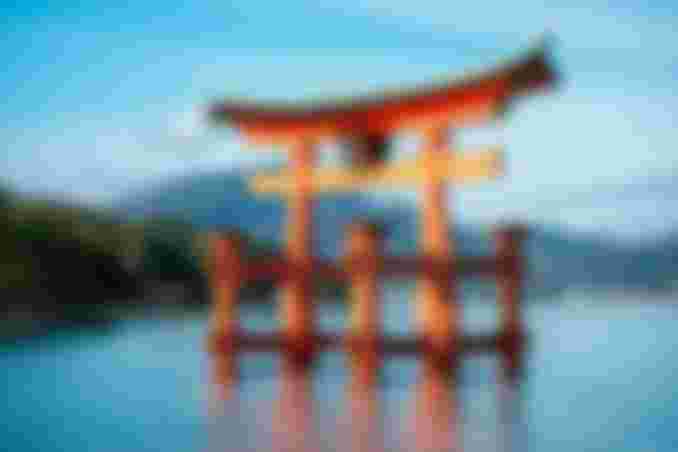Imagine a religion with no systematized doctrine or theology.
No sacred texts, no founder.
A religion in which many people practice the rituals but don't claim to be religious.
This religion is Shinto.

Often described as a tradition indigenous to Japan. But what is Shinto all about?
Well, it's in the name itself, Shin and To which can be translated as 'the way of the kami'
And what are 'Kami'? The word Kami is tough to translate into english. Some translate is as gods or spirits, but kami are way more complicated than that.
According to Shinto mythology recorded in the Kojiki Shoki, 8th century texts that are part myth and part history, the kami Izanami and Izanagi crated the earthly realm. This heavenly duo stirred the ocean with a spear and the salt that dripped down created the first island. They populated the world with all sorts of kami and natural phenomena, including their three noble children, the Sun Goddess Amaterasu and her brothers, the Moon God Tsukuyomi and Susano the Storm God.
The term kami can also refer to impersonal divine forces. A kami might be the spirit of a natural feature, like a river or mountain; A natural force, like wind, thunder ot fire; Kami may also inhabit sacred man-made objects such as mirrors, swords and comma-shaped jewels called Magatama. These objects also make up the three imperial regalia- sacred treasures passed down to the emperor by Amaterasu to signify his divine authority.
Even certain humans can become kami after they die, such as Tenjin, the Kami of Education. Tenjin is the diefied 10th century scholar, Sugowara no Michizane, whose spirit was believed to have haunted the court until a shrine was built for him.
Today, students and parents will pray to him for success on their entrance exams.
It is sometimes said that there are 8 Million Kami, in other words, countless kami. However, Kami are very different from the concept of Gods in other religions. Especially in religions like Christianity, Judaism and/or Islam, in which God is 'transcendent'.
Kami are down to earth, meaning that Shinto does not distinguish between a natural and a supernatural reality. There is one reality that humans and Kami inhabit together, but it's split between the realm that we can see and an invisible realm called Yukai.
Kami are also not omnipotent, and they're not necessarily good or evil too. Kami have generative powers called 'musubi' and encourage harmonious relationships between humans and other living beings. On the flip side, they can also punish people with illness, misfortune and even natural disasters when angry.
What are the origins of Shinto?
Keeping in mind that there's not a single orthodox Shinto tradition, scholars have traced Kami veneration back to ancient times. Dr. Helen Hardacre, a scholar of japanese Religion from Harvard University, writes that the Yayoi period, between 400BCE - 300CE is the earliest we can identify ritual practices that are reasonably linked to Shinto practice later, such as ritual objects like bronze bells called 'Dotaku' and the 'Magatama'.
But the term 'Shinto' only appears in the 6th century when Buddhism spread to Japan. Buddhism had such a huge influence on Shinto that the two were practically indistinguishable for big parts of Japanese history.
Kami veneration began as a super local practice, focusing on performing rituals for the good of the community and agricultural production. Each villager clan had its own rituals and patron Kami, known as 'Ujigami'. Over time, people migrated and merged into states until the establishment of a unified system of rule with the Yamato Court, about 250 - 710CE.
The Yamato claims that their divine ancestor, Amaterasu, gave them the right to rule. They promoted their own ritual traditions and became major supporters of shrines who supported the court in return. Still, each shrine had its own myths and rituals even though they might enshrine the exact same Kami as the other shrines. In fact, many powerful shrines had their own school of Shinto too, including the Ise Shrine complex where Amaterasu is enshrined.
However, local shrine traditions continued to be the most relevant for the masses, although certain Kami and major sites gained wide popularity in the medieval and Tokugawa periods.
Shinto underwent a huge transformation in the 19th century when the leaders of the Meiji Restoration overthrew the Samurai Government in favor of the emperor. The state promoted the Ise Shrines and public veneration of Amaterasu and the emperor. Two new categories of Shinto were created, States Shinto - a state sponsored program for civil rituals; and Sect Shinto - referring to Shinto traditions and new religious movements, related to Shinto that were designated as private religious organizations.
After World War II, the western powers legally classified Shinto as a religion and separate it from the state.
Shinto is more about what you practice than what you believe.
Shinto has its own moral philosophy.
Shinto promotes purity, sincerity and gratitude as its primary virtues.
While Shinto teaches that improper and harmful actions called 'tsumi' can pollute a person, it really isn't equivalent to the Christian concept of original sin, because humans are not considered to be innately or permanently polluted. Yes, people should try to avoid pollution when they can, but the pollution that inevitably accumulates can be purified through rituals, which leads us to shrine practice.
Today, Kami veneration is done at shrines or 'Jinja'. There are somewhere between 80 thousand and a hundred thousand shrines in Japan, and even some across the world. They can range from structures the size of a mailbox to the massive Ise Grand Shrine Complex., which includes a total of 125 shrines.
You can identify a Shinto shrine from a Buddhist temple by its iconic 'Torii' gate, which represents the boundary of the shrine's sacred precint. Shrines can have one or thousands of toii gates like the famous Fushimi Inari in Kyoto.
Ropes woven out of straw or hemp called 'Shimanawa' also mark off sacred space. Shimanawa are hung with white paper, shaped like lightning bolts that symbolize purification. You'll often see Shimanawa hanging on Torii gates, ritual washing stations, and sacred rocks and trees.
Shrines are where the Kami are thought to dwell when they interact with humans. They can enshrine just one or a bunch of different Kami. Everyday, Shinto priests conduct rituals for the Kami which involve purification, offerings, and chanting prayers called 'Norito'. Sometimes, dances are performed to entertain the Kami. In exchange for a donation, shrine visitors can request priests to perform personal prayers on their behalf and receive ritual items, such as amulets, fortunes and other charms.
Tens of thousands of Shinto priests manage these shrines. Both men and women can become Shinto priests, and unlike Catholic priests, or some Buddhist monks, Shinto priests can marry and have kids. Now, many priests come from specific shrine families, but technically, anyone can become one.
People can visit Shinto shrines as frequently or infrequently as you like, tons of people visit shrines for seasonal rituals and festivals throughout the year, and rites of passage like weddings or the birth of a child. Even if a person doesn't regularly visit a shrine, they'll often go for pray for blessings during the New Year.
During a typical visit, you first bow at the first torii gate to show respect to the Kami, then visit a washing station with flowing water and wooden ladles called 'Temizuya', after you've purified yourself, you go greet the Kami, ring the bell, throw a coin as an offering, bow twice, clap twice to get the Kami's attention, and bow once more when you're finished. Before you leave, you can hang a vote of plaque to leave behind a prayer and commemorate your visit with a special collectible stamp, called a 'Goshuin'.
Even though Shinto is one of the two major religions in Japan today, measuring religiosity in Japan is notoriously difficult due to contradictory data. Anywhere between 50 to 70 percent of the population visit shrines, but the majority have reported in government surveys that while they visit shrines all the time in temples and participate in rituals, they don't have a religious affiliation and don't consider themselves to be religious.
For a lot of westerners, this is a very different way to think about religious affiliation. In Japan, you can bring your kinds to the Shinto shrine, attend the New Years festivals or buy an amulet at a shrine whiteout ever identifying as Shinto. In fact, Shinto priests are often happy for people of different religions to visit shrines and pay their respects to the Kami as long as they do it correctly and respectfully.
